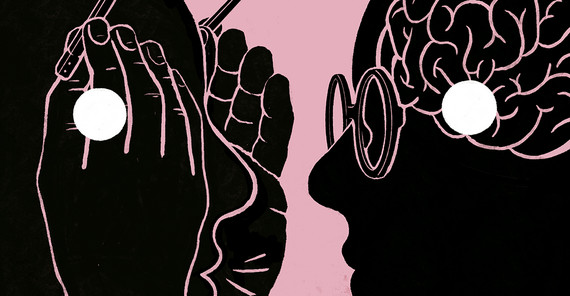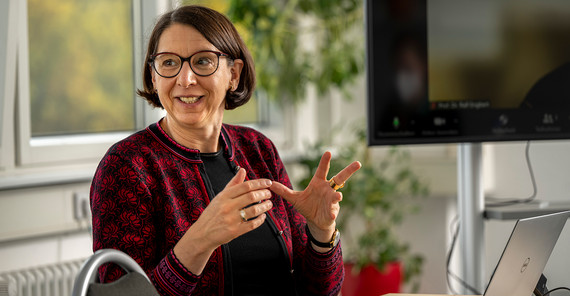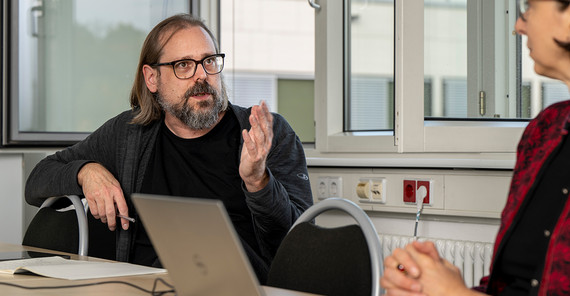What distinguishes Potsdam’s cognitive sciences?
Ralf Engbert: A specific feature is the fact that interdisciplinary research projects in cognitive science have existed since the University of Potsdam’s founding years. We can look back on long-term collaborations between psychology and linguistics on the one hand and mathematics, physics, and computer science on the other. As a result, we have developed a particularly good mutual understanding of the perspectives of other disciplines – which of course facilitates establishing new collaborative research initiatives. In addition, many connections and a lively exchange of methods have developed among the numerous laboratories in the different working groups. For example, it is certainly unusual that the BabyLAB has crossed the traditional divide between psychology and linguistics by studying parallels in the development of language and cognition. Finally, the cognitive sciences have developed exceptionally good research methods in their long-standing cooperation with the natural sciences. This becomes visible in initiatives such as the summer school “Statistical Methods for Linguistics and Psychology”, initiated by Prof. Shravan Vasishth, which draws international young researchers to Potsdam every year.
Birgit Elsner: This tradition in interdisciplinary research of the Potsdam cognitive sciences is indeed unique. It has resulted in many publications and large-scale interdisciplinary research projects, such as the Collaborative Research Center (SFB) 1287 “Limits of Variability in Language” in linguistics. There are also two projects in SFB 1294 “Data Assimilation” involving colleagues from psychology and linguistics.
David Schlangen: In the cognitive sciences, a strategic appointment approach has been pursued for a long time: The aim is to organize the departments in such a way that interdisciplinary collaboration is and remains to be possible.
Engbert: A good team increases the chances of acquiring funding for larger research projects. And conversely, one should not underestimate the fact that a collaborative research center creates an extremely attractive environment for young researchers. Our strategy is a self-enhancing process because all of this contributes to research strength.
Elsner: Not least, the diversity of the applied methods is what makes Potsdam’s cognitive sciences so successful.
Could you specify that a bit more? Which specific research methods, which laboratories characterize Potsdam?
Elsner: On the one hand, we have the traditional experiments to observe people’s behavior. In the BabyLAB, for example, we use video recordings, and here and in other labs we use eye tracking to measure with pixel precision in the range of milliseconds how a person’s gaze moves across a screen. At the University of Potsdam, there are also laboratories that specialize in speech perception and production. They are able to record, for example, the muscular movements of the tongue during speech. In neurophysiological laboratories, we also record psychophysiological measures that can provide information about our mental states: for example, skin resistance, which can indicate whether someone is currently agitated. Finally, we can record brain activity with electroencephalograms (EEG).
In Potsdam, we also have experts for mathematical and computer modeling of cognitive processes. This broad repertoire of methods enables us to answer research questions about linguistic or non-linguistic cognition. Our researchers also share their expertise to initiate joint research projects.
Schlangen: Our computational linguistics lab, where we study interactions with humanoid robots, is extraordinary, too. In preparation for the cluster of excellence, we plan to use robots for experiments in psycholinguistics because they are very well suited as extremely controllable counterparts. Prof. Audrey Bürki from linguistics is currently building a driving simulator. She is studying how much cognitive capacity driving ties up and how that affects speech production. When it comes to eye tracking, Potsdam is at the top. When Reinhold Kliegl established eye movement research at the university, it was pioneering work in Germany. This has been continued by Ralf Engbert and other researchers. I believe that the variety of empirical methods available to us is a unique selling point of Potsdam.
Elsner: Eye tracking has long been used in Potsdam in reading research, but also beyond. In the BabyLAB, we use eye movement measurements to explore infants’ thinking and language acquisition. This is an extremely helpful method because babies cannot express themselves verbally. We have to infer what is going on in their heads from their behavior.
Engbert: In reading research, we use eye tracking and eye-movement-dependent displays to study how readers process words. This allows us to check very precisely how far the cognitive processing of individual words has progressed. In this way, we learn a great deal about process models of eye movement control during reading. This knowledge can also be used in other areas.
Schlangen: In short, we can say that in Potsdam we have both the equipment and the experts who use it to collect high-quality data – both from behavior and physiological signals. When we measure how the hands move in three-dimensional space during movement tracking, or when we use an app to ask people about their current motivational state over an extended period of time, we obtain data with high temporal resolution - from milliseconds to days to years. The cluster of excellence has the aim to meet the challenge of using state-of-the-art mathematical and computational methods to form larger integrative models and thus explain the dynamics of cognition and behavior.
You mentioned the cluster of excellence for which you want to apply in the next round of the excellence initiative. What will be its focus?
Elsner: We are planning four research areas. First, there is “Language and Cognition” with the established longstanding research tradition in psychology and linguistics. Among other things, research here will examine how the processing and production of language is influenced by non-linguistic processes such as attention. In addition to the two SFBs, this is based on the DFG Research Group 2253 on the interplay of language and cognition in early human development, which also extends into the second area of “Development and Learning”. The focus here is on dynamic changes in cognition, language, knowledge, and skills that emerge throughout the life course but also in short-term learning processes. In the third area, “Motivation and Behavior,” colleagues from the sports and health sciences investigate the cognitive foundations of health-oriented behavior. For example, why it is often difficult to drink less alcohol or exercise more. At the same time, we want to strengthen cooperations with the educational sciences to look at the dynamics of learning and educational processes and find out how people acquire new skills.
Engbert: “Mathematical and computational modeling” is the fourth area. Statistical modeling has always been a strength of the cognitive sciences. In the last 20 - 30 years, we have also gained an increasing variety of process-oriented explanatory approaches. There are computational models that are more biologically motivated and those that are more based on cognitive theories. There are also approaches from mathematics and computer science, such as machine learning, which make few prior assumptions about cognitive processes. In the planned cluster of excellence, we want to investigate what contribution can be made by the different modeling approaches.
What does that mean in detail? Which questions do you want to investigate in the cluster of excellence?
Elsner: Because cognitive processes are very dynamic, we need more research on the variation of behavior over time. An eye movement, for example, creates a data point every millisecond: In the BabyLAB, we measure at what time children look at a point on the screen that is important for our research question. Some babies’ eyes arrive at this point after 100 milliseconds, but others’ only later. Thus, we calculate a numerical value for each child that summarizes their gaze behavior – the data are “aggregated”. But the course of movements would also be interesting: Where does the child’s gaze start? And if the child takes longer, what other points might he or she have looked at? We can now collect such data with a high temporal resolution, but we also need appropriate evaluation methods. The goal of the cluster of excellence would be to investigate dynamic processes in cognition and behavior on different time scales, that is, in the millisecond range in which our thinking or eye movements take place, as well as over longer periods of time when it’s about learning or the course of human development.
Engbert: Dynamical systems are one of the domains of mathematics and physics. We would like to use their modeling possibilities and bring them together with cognitive science research to obtain more precise explanations of why a process develops. For example, how do a person’s different prior experiences affect how they process something cognitively? As far as language processing is concerned, several models are available that explain individual aspects of this process. What is missing are models that represent processing in all its complexity. I think it would be presumptuous to look for a theory that explains everything. But we at least want to see which of the existing models, or which combinations of models, are best suited to explain cognitive processes more holistically.
Schlangen: Machine speech processing is another vivid example of dynamic processes. Most models for today’s dialog systems, whether as chatbots or voice assistants, assume that a spoken or written utterance must be completed before information processing can begin. So a voice assistant or humanoid robot waits until a sentence, for example, is complete. This is extremely simplistic and unrealistic because human information processing, or cognition, operates continuously. Many of the existing models don’t consider this time aspect, and we want to bring it back in. If we can model how language processing occurs bit by bit in time, it can improve the quality of interaction with artificial systems. For example, humanoid robots can exhibit behaviors such as nodding their heads while they are still listening rather than when we pause. But not only speaking, reading also takes place in time. After all, a longer sentence is not taken in all at once, but the eyes move over the individual words.
Elsner: Exactly, the brain takes in a text bit by bit, constantly referring to prior experience. I also don't have to read every word because I can anticipate certain verbal constructions. But of course, it also happens that such expectations are not met. That’s why tracking these processes is so important.
Why is Potsdam the right place for a cluster of excellence in the cognitive sciences?
Engbert: We have long interdisciplinary experience in researching various aspects of human information processing. Today, many colleagues at our university are working on structurally similar questions and are creating new cross-connections. This is promoted by similar measurement methods, some overlap in the research topics and the increasing availability of theoretical models. When you work together rather than side by side, you can learn a lot from each other.
Elsner: It is also important to note that the university’s decision to promote the cognitive sciences as a research focus is now bearing fruit. This has received a lot of attention in Germany. The fact that the university has created supporting structures to push-start such major research initiatives is a key component.
Schlangen: The two collaborative research centers, which were recently extended into the second funding period, have shown that we can collaborate very successfully across disciplines. Now we can say with a lot of self-confidence: We also dare to apply for a cluster of excellence! The prerequisites are in place. The draft proposal is a natural next step, the logical consequence, so to speak.
Elsner: There are various substantive threads and structural conditions that only come together for what we have in mind at the University of Potsdam. That’s why now is the right time and this is the right place.
How will you integrate and promote young researchers?
Schlangen: In addition to supporting PhD candidates and postdocs, we are planning junior research groups with a high degree of independence and a strong mentoring program. We have very well-functioning degree programs, such as the Bachelor “Cognitive Sciences” and the two international Masters “Cognitive Science - Embodied Cognition” and “Cognitive Systems”. We can offer research-oriented teaching and attract suitable candidates for doctoral positions and subsequently for postdoctoral positions. At the professorial level, the age structure was important to us, which is why we have also included younger colleagues.
Engbert: A major focus will be to introduce PhD candidates and postdocs to our innovative research methods and to train them in mathematical and computational modeling as well as in the combination of measurement methods, such as collecting data at different levels of behavior. We want to lead them to academic independence at an early stage while achieving diversity at different levels. Gender balance is very good in psychology and linguistics, while modelling is still a field with more male than female scientists. In the cluster, we strive to bring together people of different genders, nationalities, social backgrounds, and physical abilities – not only at the level of project leaders, where we are already very well positioned, but also among researchers at other stages of their scientific careers.
Schlangen: We are planning to share our modeling approaches not only via summer schools, but also via Open Educational Resources for education and training at and outside the university.
Elsner: We would like to use apps or gaming tasks to let a broader public participate in our cognitive science research. These could motivate people to participate in studies and provide information about their emotions or aspects of their daily lives several times a day without having to travel to the lab. For our research on the dynamics of cognition and behavior, we need a lot of data points. We can get them reliably via laboratory studies and online methods. Our initiative is focused on basic research: We want to describe and explain how intelligent systems process information and produce behavior; how mental processes happen. This is also important for societal goals because learning and support programs or motivational aids for health-related behavior, for example, could be developed based on such findings.
The Researchers
Prof. Dr. Birgit Elsner is Professor of Developmental Psychology. Together with Prof. Barbara Höhle, she heads the Potsdam BabyLAB, studying mental development and language acquisition in the first years of life.
Mail: birgit.elsneruuni-potsdampde
Prof. Dr. Ralf Engbert is Professor of Experimental and Biological Psychology at the University of Potsdam and an expert in dynamic cognitive systems for modelling cognitive processes and eye movement analysis in the EyeLab.
Mail: ralf.engbertuuni-potsdampde
Prof. Dr. David Schlangen is Professor of the Foundations of Computational Linguistics and investigates verbal and non-verbal interactions between human and artificial agents, amongst other places at the computer-linguistics laboratory of the University of Potsdam.
Mail: david.schlangenuuni-potsdampde
More articles about Potsdam’s cognitive sciences:
www.uni-potsdam.de/de/nachrichten/detail/2021-04-13-wir-waren-exotisch-der-linguist-gisbert-fanselow-und-der-psychologe-reinhold-klie
www.uni-potsdam.de/de/nachrichten/detail/2022-09-27-ueberraschende-gespraechspartner-robotern-das-sprechen-beibringen
This text appears in the university magazine Portal Wissen - Zwei 2023 „Exzellenz“ (PDF).




